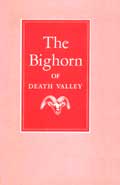.gif)
MENU
![]() Contents
Contents
|
Fauna of the National Parks — No. 6
The Bighorn of Death Valley |

|
CONTENTS
Introduction
a. How and Why This Study Was Begun
b. Previous Studies of Death Valley Bighorn
c. Chronology and Scope of the Present Study
d. Cast of Characters
Life History of the Death Valley Bighorn
a. Habitat
b. Food
Kinds
Shortages
A Factor in Distribution and Survivalc. Water
Requirements by Season
Amounts Taken
Shortages
Caused by Man
Caused by Wild Burros
Natural
Acceptance of New Sources
Watering Behavior
A Factor in Distribution and Survivald. Home Area
e. Trails
f. Activity
g. General Habits
Wariness
By Age Class and Sex
"Freezing"
Curiosity
Length of Retreat When Frightened
Response to Humans and Equipment
Response to Noises
Herd Leadership
Gregariousness
Play
Memory
Climbing Ability
Fighting
Rest
Sanitation
Urinationh. Communication
Voice
"Clonking"
Stamping
Hearing
Touch
Movement
Appeasement
Showing Rump Patch
Vision
Sense of Smell
Signpostsi. Reproduction
Males
Rutting Period
Feeding Behavior
Distance Traveled
Attention to Females
Fighting with Other Males
Response to Young
Group Activity
Females and Young
Response to Males
Selection of Lambing Area
Number of Young
Birth of Young
Growth, Behavior, and Care of Youngj. Structure
Size
Horns
Track Measurements
Pelagesk. Diseases and Parasites
l. Population Dynamics
Longevity
Herd Composition
Numbers
Census Methods
Distribution
Field Identification
Sign Reading
Usefulness of Beds
Usefulness of Pellets
Associative Principle
Usefulness of Tracks and Soil
Chief Causes of Mortalitym. Competitors and Enemies
Man
Deer
Wild Burro
Mountain Lion and Other "Predators"
Index (omitted from the online edition)
MAPS
1 Death Valley National Monument
2 Bighorn Distribution
TABLES
1 Observations upon which report is based
2 Visits of sheep to Nevares Spring, August and September 1957
3 Official air temperature record, Death Valley National Monument headquarters, for July, August, September, and October, 1957
4 National Park Service ground temperature readings in Furnace Creek vicinity, May—November 1957
5 National Park Service ground temperature readings at Badwater and Tule Spring, May, June, July, and August 1958
6 Hourly record of bighorn drinking at Nevares Spring, from August 11 to September 10, 1957
7 Drinking time of bighorn at Nevares Spring, 1957
8 Bighorn watering record at Nevares Spring, August 11 to September 10, 1957
9 Observations on nursing new lamb
10 Measurements of bighorn from Nevada and Arizona
11 Measurements of Death Valley ram horns, from skulls
12 Bighorn census surveys, Death Valley National Monument, 1955—59
 Top
Top
Last Modified: Thurs, May 16 2002 10:00:00 pm PDT
http://www.cr.nps.gov/history/online_books/fauna6/faunat.htm
![]()
